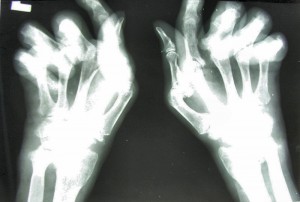Difference between arthritis and osteoarthritis
Arthritis vs osteoarthritis

Rheumatoid - X-ray image of the hand
What are arthritis and osteoarthritis?
Arthritis is normally referred to as rheumatoid arthritis which is autoimmune and inflammatory in origin affecting all synovial joints whereas osteoarthritis is a degenerative disorder affecting mostly the large joints.
Difference in presentation
Arthritis can even occur in young children and the disease is called as juvenile rheumatoid arthritis but osteoarthritis is the disease of the geriatric (elderly) age group. Rheumatoid arthritis can affect other organs of the body for example the heart and is considered more fulminant than osteoarthritis which affects only the joints.
The disease process in rheumatoid arthritis starts with autoimmune processes causing inflammation of the joint capsule resulting in excessive synovial fluid around the joints and development of fibrous tissue in the synovium. In osteoarthritis, the disease process starts after injury to the joint or in obese adults in whom the calcium levels are low and bones are weak and osteoporotic. Typically, there are decreased joint spaces and formation of osteophytes (small bony outgrowths) at the edges of the bones disturbing the smooth and rounded contour of the bones.
Rheumatoid arthritis affects smaller joints like the joints of the hands, neck, toes whereas osteoarthritis affects larger joints like knees, hip, etc. Another marked distinguishing feature is that rheumatoid arthritis affects multiple joints simultaneously but osteoarthritis affects one or two joints at a time. Rheumatoid arthritis typically occurs in waves of exaggeration and remission while osteoarthritis persists continuously, progressively worsening with age. The joints of rheumatoid arthritis are swollen, red, inflamed, tender and stiff. The stiffness is most marked in the morning after waking up when the patient experiences immense pains on attempting to move the joints. As the day advances the pains gradually reduce and minimal or no pain is experienced by evening. Other symptoms like fatigue, lethargy, mild fever, loss of appetite and weight loss might also be experienced by certain patients. In joints affected by osteoarthritis, the oedema and pain are present but persist throughout the day. Knees are most commonly affected due to osteoarthritis. Deformities are a late complication of rheumatoid arthritis but are rare in osteoarthritis.
Difference in investigations
Investigations for rheumatoid arthritis are rheumatoid factor, ASO titers, CRP titers and X-rays of various joints. All these titers tend to be elevated and X-rays will show deformities and presence of free fluid around the joints. The most important investigation for osteoarthritis is an X-ray of the affected joint. Since osteophytes are bony in origin, they can be visualized on X-ray. On examination, osteoarthritic joints, especially the knees, will show a presence of crackling noise also called as crepitus on movement.
Difference in management
There is no cure for rheumatoid arthritis but palliation can be achieved through aggressive medication and exercises. The medications for rheumatoid arthritis consists of intake of NSAIDs (non-steroidal anti-inflammatory drugs), DMARDS (disease modifying anti-rheumatic drugs), methotrexate, gold drugs, COX2 inhibitors and steroids being the last resort. For osteoporosis, reducing weight and avoiding obesity are the mainstay of treatment. Medications will relieve the pain and calcium supplements are extremely helpful to maintain healthy bones. Walking and physiotherapy are beneficial for osteoarthritis patients. Knee or hip replacement surgery might be the last resort in unyielding cases.
Summary: Rheumatoid arthritis and osteoarthritis are very different conditions of the joints. Rheumatoid arthritic joints become pain free on continued use of the joint whereas osteoarthritic joints will be fatigued on continuously using the joints. Rheumatoid arthritis affects other systems apart from joints and manifests typically as an early morning joint stiffness that improves as the day progresses. Osteoarthritis presents as progressively worsening joint pains in large joints like knees, requiring intense physiotherapy and medications.
- Difference between near sightedness and far sightedness - January 21, 2015
- Difference between Diverticulosis and Diverticulitis - January 20, 2015
- Difference between Prilosec and Nexium - January 19, 2015

Thanks for a great article!